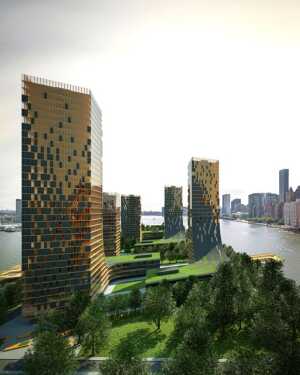After ruinous fires that laid waste to wide swaths of the urban landscape, cities more than a century ago were eager for technology to come to the rescue, with new building materials and methods.
And of course, history did not disappoint. The Monadnock building in Chicago (Burnham & Root, 1891) had its record-setting load-bearing masonry wall and iron frame; the staircases sported aluminum. It was off to the races from there, with curtain-walled towers of glass and concrete and steel.
Wood, meanwhile, was relegated to furniture – some of it quite glorious – and interior design. Building materials sourced from trees were fine for an arts-and-crafts bungalow, but hard (no pun intended) to take seriously as the central component of major buildings.
So what exactly is Vancouver-based architect Michael Green thinking when he proposes using wood to erect urban skyscrapers and multifamily structures of up to 30 stories? “Earth grows our food,” he says in his 2013 TED Talk. “We should move toward an ethic that the earth should grow our homes.”
For one thing, Green argues, using wood in a more systematic way would be good for sustainability. Buildings account for nearly 50 percent of all global greenhouse gas emissions. In the construction process, 3 percent of the world’s energy is used for making steel, and 5 percent for concrete.
Wood grows by the power of the sun, and harvesting wood through sustainable forestry practices – enough wood for a 20-story building is grown every 13 minutes, he says – would also be a form of sequestration of carbon, which is otherwise released when a tree falls and decomposes. And there are a lot more dead trees around, not coincidentally because of climate change impacts. The pine beetle, flourishing due to warmer temperatures, has already devastated millions of acres in the Intermountain West.
Rather than building with two-by-fours, modern-day wood construction would be accomplished using state-of-the-art methods based on super-compressed mass timber panels – essentially giant, sturdy Lego-like assembly. The compression also contributes to protecting against fire, which Green concedes is the first question he gets when he talks about building with wood. These denser wood building blocks are actually difficult to burn – like a big fat tree stump in a fireplace – and would of course exist within the context of 21st-century fire suppression systems, including sprinklers.
The vast majority of city building codes, largely based on the tragedies of a century ago, limit the height of wood buildings, often to a mere four stories.
Perhaps Green’s most convincing argument is the fact that some three billion people will be moving into cities in the coming decades, chronicled in Solly Angel’s book Planet of Cities among others, and they are going to need housing. Accommodating all those mostly poor people requires more sustainable construction, he says.
Sweden has already approved a 30-story wood tower, and Vancouver is reviewing Green’s proposal for a structure nearly as high. His white paper, “The Case for Tall Wood Buildings,” is available at the Wood Coalition website.
Green continues to believe it might be wood’s big moment. Deep skepticism greeted the Monadnock and the Eiffel Tower, he notes, but soon those then-new construction materials and methods were fully accepted. What it took was a turning point of imagination. “The engineering,” he says, “is the easy part.”
Reprinted with permission from The Atlantic Cities. Copyright 2013 by The Atlantic Monthly Group.






